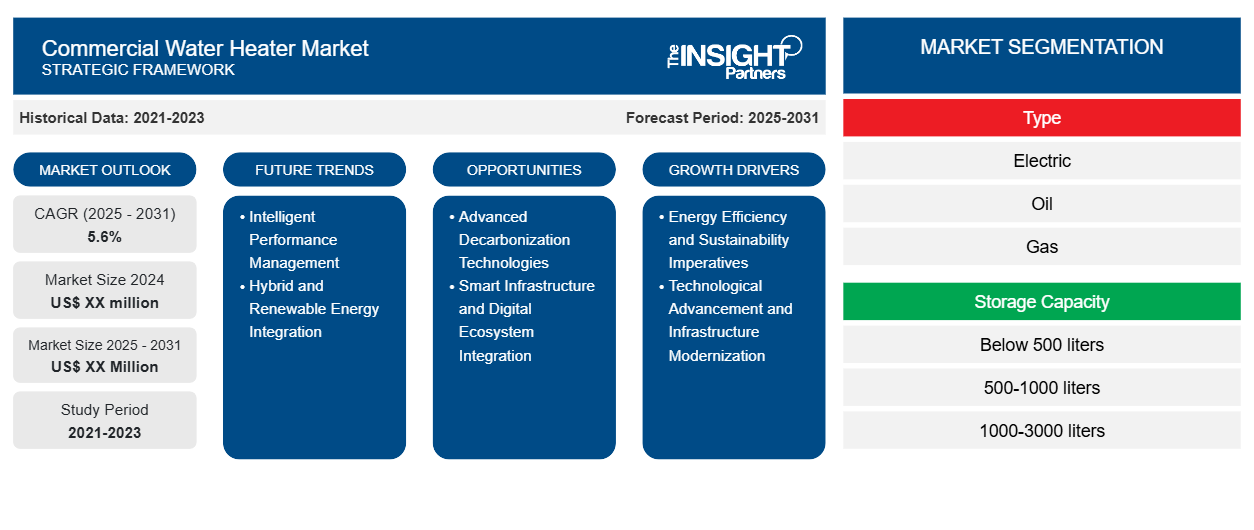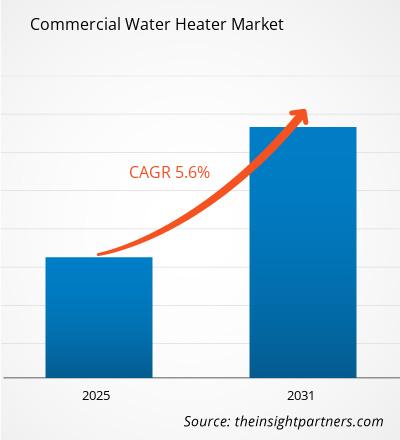The Commercial Water Heater Market is expected to register a CAGR of 5.6% from 2025 to 2031, with a market size expanding from US$ XX million in 2024 to US$ XX Million by 2031.
The report is segmented by Type (Electric, Oil, Gas, Solar, Hybrid, Heat Pump, and Others), Storage Capacity (Below 500 liters, 500-1000 liters, 1000-3000 liters, 3000-4000 liters, and Above 4000), Rated Capacity (0-10 kW, 10-50 kW, 50-100 kW, and Above 100 kW), End-user (Healthcare, Offices, Restaurants, Institutes, and Others). The global analysis is further broken-down at regional level and major countries. The report offers the value in USD for the above analysis and segments
Purpose of the Report
The report Commercial Water Heater Market by The Insight Partners aims to describe the present landscape and future growth, top driving factors, challenges, and opportunities. This will provide insights to various business stakeholders, such as:
- Technology Providers/Manufacturers: To understand the evolving market dynamics and know the potential growth opportunities, enabling them to make informed strategic decisions.
- Investors: To conduct a comprehensive trend analysis regarding the market growth rate, market financial projections, and opportunities that exist across the value chain.
- Regulatory bodies: To regulate policies and police activities in the market with the aim of minimizing abuse, preserving investor trust and confidence, and upholding the integrity and stability of the market.
Commercial Water Heater Market Segmentation
Type
- Electric
- Oil
- Gas
- Solar
- Hybrid
- Heat Pump
- Others
Storage Capacity
- Below 500 liters
- 500-1000 liters
- 1000-3000 liters
- 3000-4000 liters
- Above 4000
Rated Capacity
- 0-10 kW
- 10-50 kW
- 50-100 kW
- Above 100 kW
End-user
- Healthcare
- Offices
- Restaurants
- Institutes
- Others
You will get customization on any report - free of charge - including parts of this report, or country-level analysis, Excel Data pack, as well as avail great offers and discounts for start-ups & universities
Commercial Water Heater Market: Strategic Insights

-
Get Top Key Market Trends of this report.This FREE sample will include data analysis, ranging from market trends to estimates and forecasts.
Commercial Water Heater Market Growth Drivers
- Energy Efficiency and Sustainability Imperatives: Increasing environmental regulations and corporate sustainability goals are dramatically transforming the commercial water heater market. Organizations are actively seeking advanced heating technologies that dramatically reduce energy consumption, minimize carbon footprints, and align with stringent green building standards. Modern commercial water heaters are evolving to incorporate high-efficiency designs, renewable energy integration, and intelligent energy management systems that optimize performance while significantly reducing operational costs and environmental impact across hospitality, healthcare, industrial, and educational sectors.
- Technological Advancement and Infrastructure Modernization: Rapid technological innovations are accelerating commercial water heater market expansion through sophisticated engineering solutions. Infrastructure renewal efforts, particularly in aging commercial and institutional buildings, are driving demand for next-generation water heating technologies. Advanced systems now offer unprecedented levels of performance, incorporating smart connectivity, predictive maintenance capabilities, and modular designs that provide greater flexibility, reliability, and adaptive functionality across diverse commercial applications.
Commercial Water Heater Market Future Trends
- Intelligent Performance Management: Commercial water heater technologies are experiencing a transformative trend towards comprehensive intelligent performance management. Advanced systems now integrate artificial intelligence, machine learning algorithms, and IoT connectivity to enable real-time monitoring, predictive maintenance, and dynamic energy optimization. These intelligent solutions can automatically adjust heating parameters, predict potential system failures, and generate detailed performance analytics, transforming water heaters from passive infrastructure components to active, data-driven operational assets.
- Hybrid and Renewable Energy Integration: The commercial water heater market is witnessing a significant trend towards hybrid and renewable energy integration. Manufacturers are developing sophisticated systems that can seamlessly combine multiple energy sources, including solar thermal, heat pump technologies, electric, and gas-powered configurations. This trend supports organizations' sustainability objectives by creating flexible, adaptable water heating solutions that can optimize energy utilization, reduce operational costs, and minimize environmental impact across different commercial environments.
Commercial Water Heater Market Opportunities
- Advanced Decarbonization Technologies: The global transition towards decarbonization represents a critical opportunity for innovative commercial water heater technologies. Manufacturers can develop cutting-edge systems that support aggressive carbon reduction strategies, incorporating advanced heat pump technologies, hydrogen-ready configurations, and comprehensive renewable energy integration capabilities. These solutions can help organizations meet increasingly stringent environmental regulations while maintaining optimal operational performance.
- Smart Infrastructure and Digital Ecosystem Integration: Commercial water heater technologies offer transformative opportunities in developing comprehensive smart building ecosystems. Potential applications include creating fully integrated thermal management platforms that connect water heating systems with broader building management infrastructures, enabling holistic energy optimization, predictive maintenance, and real-time performance monitoring. By providing intelligent, interconnected solutions, manufacturers can support the evolution of more sustainable, efficient commercial infrastructure.
Commercial Water Heater Market Regional Insights
The regional trends and factors influencing the Commercial Water Heater Market throughout the forecast period have been thoroughly explained by the analysts at The Insight Partners. This section also discusses Commercial Water Heater Market segments and geography across North America, Europe, Asia Pacific, Middle East and Africa, and South and Central America.
Commercial Water Heater Market Report Scope
| Report Attribute | Details |
|---|---|
| Market size in 2024 | US$ XX million |
| Market Size by 2031 | US$ XX Million |
| Global CAGR (2025 - 2031) | 5.6% |
| Historical Data | 2021-2023 |
| Forecast period | 2025-2031 |
| Segments Covered |
By Type
|
| Regions and Countries Covered |
North America
|
| Market leaders and key company profiles |
|
Commercial Water Heater Market Players Density: Understanding Its Impact on Business Dynamics
The Commercial Water Heater Market is growing rapidly, driven by increasing end-user demand due to factors such as evolving consumer preferences, technological advancements, and greater awareness of the product's benefits. As demand rises, businesses are expanding their offerings, innovating to meet consumer needs, and capitalizing on emerging trends, which further fuels market growth.

- Get the Commercial Water Heater Market top key players overview
Key Selling Points
- Comprehensive Coverage: The report comprehensively covers the analysis of products, services, types, and end users of the Commercial Water Heater Market, providing a holistic landscape.
- Expert Analysis: The report is compiled based on the in-depth understanding of industry experts and analysts.
- Up-to-date Information: The report assures business relevance due to its coverage of recent information and data trends.
- Customization Options: This report can be customized to cater to specific client requirements and suit the business strategies aptly.
The research report on the Commercial Water Heater Market can, therefore, help spearhead the trail of decoding and understanding the industry scenario and growth prospects. Although there can be a few valid concerns, the overall benefits of this report tend to outweigh the disadvantages.
Frequently Asked Questions
What are the future trends of the Commercial Water Heater market?
What are the deliverable formats of the market report?
What are the options available for the customization of this report?
What is the expected CAGR of the Commercial Water Heater market
What are the driving factors impacting the global Commercial Water Heater market?
- Historical Analysis (2 Years), Base Year, Forecast (7 Years) with CAGR
- PEST and SWOT Analysis
- Market Size Value / Volume - Global, Regional, Country
- Industry and Competitive Landscape
- Excel Dataset
Recent Reports
Related Reports
Testimonials
Reason to Buy
- Informed Decision-Making
- Understanding Market Dynamics
- Competitive Analysis
- Identifying Emerging Markets
- Customer Insights
- Market Forecasts
- Risk Mitigation
- Boosting Operational Efficiency
- Strategic Planning
- Investment Justification
- Tracking Industry Innovations
- Aligning with Regulatory Trends





















 Get Free Sample For
Get Free Sample For